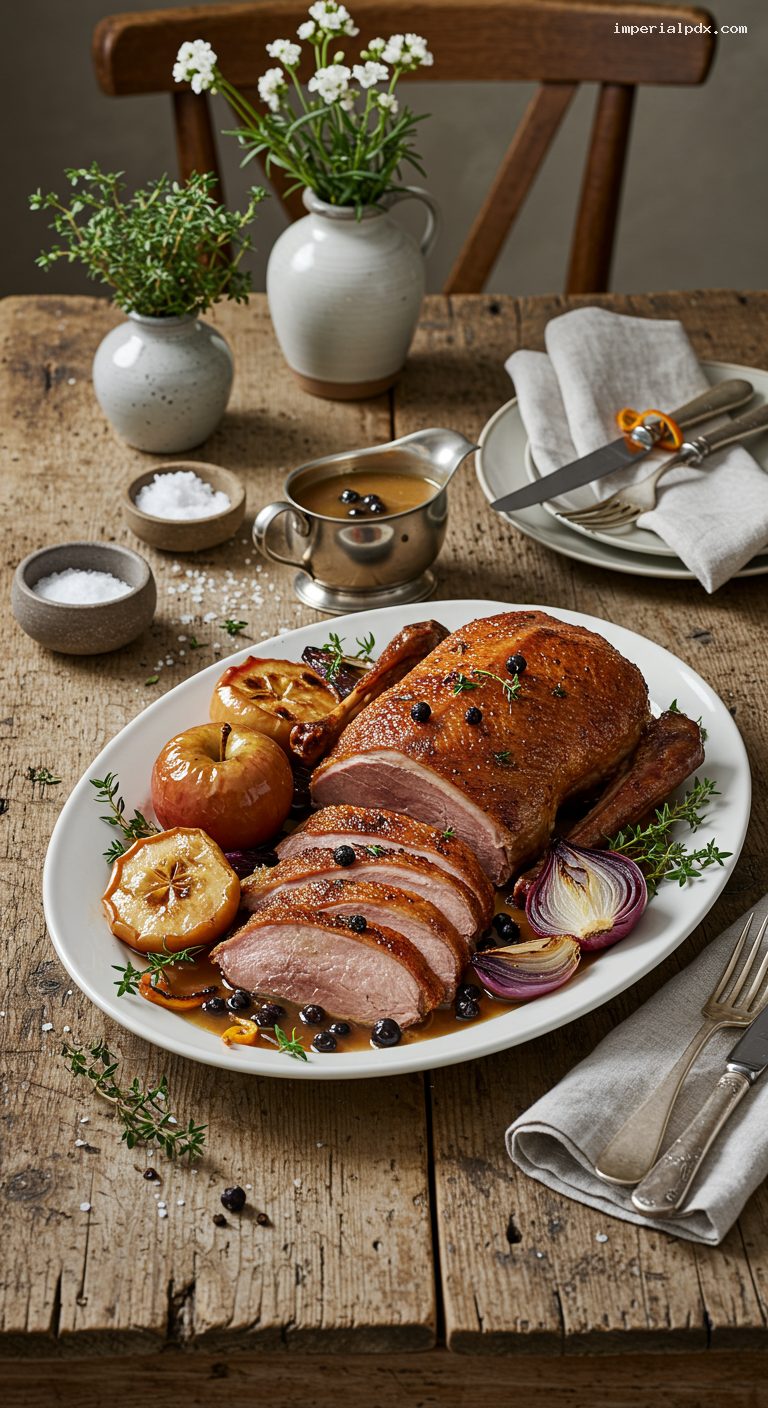Quick Recipe Version (TL;DR)
Quick Ingredients
- 1 whole goose (10–12 lb / 4.5–5.5 kg), giblets and neck reserved
- 2 tbsp kosher salt, 1 tsp black pepper
- 4 firm apples (about 2 lb), 3 large onions
- 6 sprigs thyme, 2 sprigs rosemary, 2 bay leaves
- 1 head garlic, halved; peel of 1 orange (optional)
- 1 cup water or dry cider (for the pan)
- 3 tbsp goose fat (from roasting) + 3 tbsp flour
- 1/2 cup dry white wine or dry cider
- 2–3 cups giblet stock (from neck/giblets)
- 8 juniper berries, lightly crushed; 1 tbsp redcurrant jelly; 1 tsp sherry vinegar
Do This
- 1. Dry-brine: Pat goose dry, prick skin all over (avoid meat), rub with salt and pepper; air-dry uncovered in fridge 12–24 hours (optional but best).
- 2. Preheat to 425°F (220°C). Set rack low. Scatter apples, onions, herbs, garlic in a roasting pan; add 1 cup water/cider. Set a rack over the bed.
- 3. Roast goose breast-side up 30 minutes at 425°F. Drain off rendered fat; baste skin with a little of it.
- 4. Reduce to 350°F (175°C). Roast 1 hour 45 minutes more, basting with goose fat every 20 minutes; drain excess fat as needed.
- 5. Doneness: Thigh meat 165–170°F (74–77°C) and skin deep golden. Blast at 425°F for 10 minutes if you want extra crisp.
- 6. Rest 30 minutes. Meanwhile make gravy: make a roux with 3 tbsp goose fat + 3 tbsp flour; deglaze with wine; add stock and crushed juniper; simmer to glossy; finish with jelly and vinegar; season.
- 7. Carve and serve over the apples and onions with the juniper gravy. Save extra goose fat.
Why You’ll Love This Recipe
- Ultra-crisp, glassy skin thanks to dry-brining, high-heat rendering, and fat basting.
- Roasting over apples and onions perfumes the meat and creates a ready-made side.
- Deeply savory, glossy juniper gravy that balances richness with woodland aromatics.
- Step-by-step timing and temperatures designed for home ovens and stress-free success.
Grocery List
- Produce: 4 firm apples, 3 large yellow onions, 1 head garlic, 1 orange, 1 carrot, 1 celery stalk, fresh thyme, fresh rosemary
- Dairy: None required (but a small knob of butter is optional for gravy gloss)
- Pantry: Kosher salt, black pepper, bay leaves, juniper berries, redcurrant jelly (or lingonberry), dry white wine or dry cider, all-purpose flour, whole peppercorns
Full Ingredients
For the Goose
- 1 whole goose, 10–12 lb (4.5–5.5 kg), giblets and neck reserved
- 2 tablespoons kosher salt
- 1 teaspoon freshly ground black pepper
- Peel of 1 orange (use a vegetable peeler for wide strips; optional but lovely)
- 1 head garlic, halved crosswise
- 6 sprigs fresh thyme
- 2 sprigs fresh rosemary
Apple–Onion Roasting Bed
- 4 firm baking apples (about 2 lb / 900 g), cored and quartered (Braeburn, Honeycrisp, or Jonagold)
- 3 large yellow onions, peeled and cut into thick wedges
- 2 bay leaves
- 1 cup (240 ml) water or dry hard cider (to start the pan and prevent scorching)
Simple Giblet Stock
- Goose neck and giblets (omit liver or add only for last 10 minutes to avoid bitterness)
- 1 small onion, chopped
- 1 carrot, chopped
- 1 celery stalk, chopped
- 6 whole peppercorns
- 1 bay leaf, small sprig thyme
- 4 cups (960 ml) cold water
Glossy Juniper Gravy
- 3 tablespoons rendered goose fat (from the roasting pan)
- 3 tablespoons all-purpose flour
- 1/2 cup (120 ml) dry white wine or dry hard cider
- 2 to 3 cups (480–720 ml) hot giblet stock (as above)
- 8 juniper berries, lightly crushed
- 1 tablespoon redcurrant jelly (or lingonberry jam)
- 1 teaspoon sherry vinegar or fresh lemon juice
- Kosher salt and black pepper, to taste

Step-by-Step Instructions
Step 1: Dry-brine and prep the goose
Remove the goose from its packaging, remove the neck and giblets, and pat the bird very dry. Using a clean needle or sharp skewer, prick the skin all over (especially the breast and the thick pockets of fat around the thighs), angling the tip downward so you pierce only the skin and fat, not the meat. Rub all over with 2 tablespoons kosher salt and 1 teaspoon black pepper. Tuck the orange peel, halved garlic, and herb sprigs into the cavity. Place the goose on a rack set over a roasting pan and refrigerate uncovered 12–24 hours to air-dry the skin for superior crispness. If you are short on time, proceed without the overnight dry; just dry as thoroughly as possible before roasting.
Step 2: Build the apple–onion bed and start the stock
Heat the oven to 425°F (220°C) with a rack in the lower third. In a large roasting pan, toss the apple quarters, onion wedges, and bay leaves. Pour in 1 cup water or dry cider. Set a sturdy rack over the apples and onions and place the goose breast-side up on the rack. In a separate saucepan, combine the goose neck and giblets (omit or add liver only for the final 10 minutes), chopped onion, carrot, celery, peppercorns, thyme, bay leaf, and 4 cups water. Bring to a boil, then simmer gently, partially covered, for 1 1/2 hours while the goose roasts. Strain and keep hot.
Step 3: Render at high heat
Roast the goose at 425°F (220°C) for 30 minutes to jump-start fat rendering and begin crisping the skin. At the 20-minute mark, baste the skin with some of the fat beginning to collect in the pan. After 30 minutes, carefully remove the pan from the oven. Tilt the pan and ladle off the rendered goose fat into a heatproof jar—save every drop; you will use it for basting and gravy (and the rest is gold for potatoes).
Step 4: Lower the heat, baste, and continue roasting
Reduce the oven to 350°F (175°C). Return the goose to the oven and roast for about 1 hour 45 minutes more, basting the skin with some of the reserved goose fat every 20 minutes and siphoning off excess fat from the pan as needed to keep the apple–onion bed from frying. Rotate the pan halfway through for even browning. If the apples and onions threaten to scorch, splash in a little water or stock to keep a thin film of moisture in the pan.
Step 5: Final crisp and doneness check
The goose is done when an instant-read thermometer inserted into the thickest part of the thigh reads 165–170°F (74–77°C), juices run clear, and the skin is deep golden and blistered. For extra crackle, raise the heat back to 425°F (220°C) for the last 10 minutes. Transfer the goose to a carving board, tent loosely with foil, and rest 30 minutes. This keeps the skin crisp while the juices redistribute.
Step 6: Make the glossy juniper gravy
Pour off all but 3 tablespoons of fat from the roasting pan (reserve the rest). Set the pan over medium heat across two burners. Sprinkle in 3 tablespoons flour and whisk, scraping up the browned bits, until the roux is smooth and toasty blond, 1–2 minutes. Deglaze with 1/2 cup dry white wine or dry cider, whisking and simmering until nearly absorbed. Gradually whisk in 2 cups hot giblet stock until smooth. Add the lightly crushed juniper berries and simmer 8–10 minutes until glossy and thick enough to lightly coat a spoon; add more stock to adjust consistency. Strain into a saucepan, then whisk in 1 tablespoon redcurrant jelly and 1 teaspoon sherry vinegar. Taste and season with salt and pepper.
Step 7: Carve and serve
Remove and discard the aromatics from the cavity. Carve the legs and thighs, then slice the breasts across the grain. Spoon the roasted apples and onions onto a warm platter, arrange the goose pieces on top, and serve with a generous pour of the juniper-scented gravy. Keep extra goose fat refrigerated for future cooking.
Pro Tips
- For the crispiest skin, the overnight air-dry is the single biggest upgrade—don’t skip if you can help it.
- Prick only the skin and fat, never the meat; piercing meat releases juices and can toughen the breast.
- Drain fat frequently. A shallow layer in the pan is good; a deep pool will fry the aromatics and smoke.
- Use convection for the final 10 minutes at 425°F (220°C) if your oven has it—watch closely to avoid overbrowning.
- A good thermometer beats guessing. Target 165–170°F (74–77°C) in the thigh for succulent meat.
Variations
- Orange and Spice: Add strips of orange peel to the cavity and 2 star anise + 4 allspice berries to the gravy instead of juniper for a subtle holiday perfume.
- Calvados Gravy: Swap the wine for 1/2 cup Calvados; add 1 extra tablespoon jelly for balance.
- Savory Mustard Glaze: Brush the goose in the last 10 minutes with 2 tablespoons Dijon mixed with 1 tablespoon honey and 1 tablespoon goose fat for a tangy sheen.
Storage & Make-Ahead
Refrigerate carved goose, apples/onions, and gravy separately, covered, for up to 3 days. Reheat goose pieces on a rack at 400°F (200°C) for 10–12 minutes to re-crisp skin, warming gravy gently on the stovetop with a splash of stock. Freeze gravy up to 2 months. Goose fat keeps chilled for 3 months or frozen for 1 year—perfect for roast potatoes. You can make the giblet stock a day ahead to streamline the cook.
Nutrition (per serving)
Approximate for 1/8 of a 10–12 lb goose with skin, apples/onions, and gravy: 820 kcal; 54 g fat; 20 g carbohydrates; 45 g protein; 1,080 mg sodium. Actual values will vary with portion size and how much fat is consumed.



